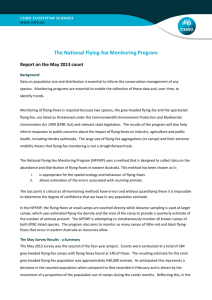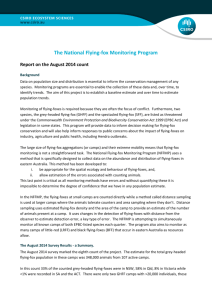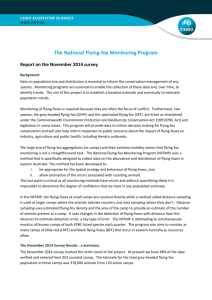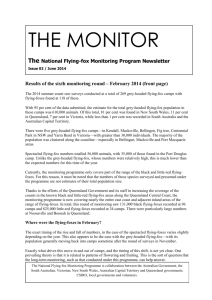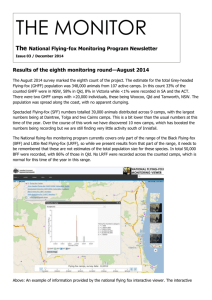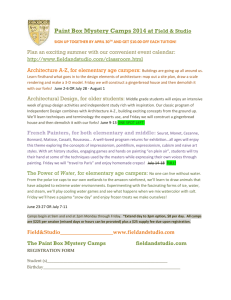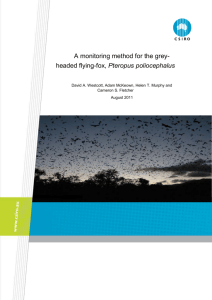The National Flying-fox Monitoring Program
advertisement
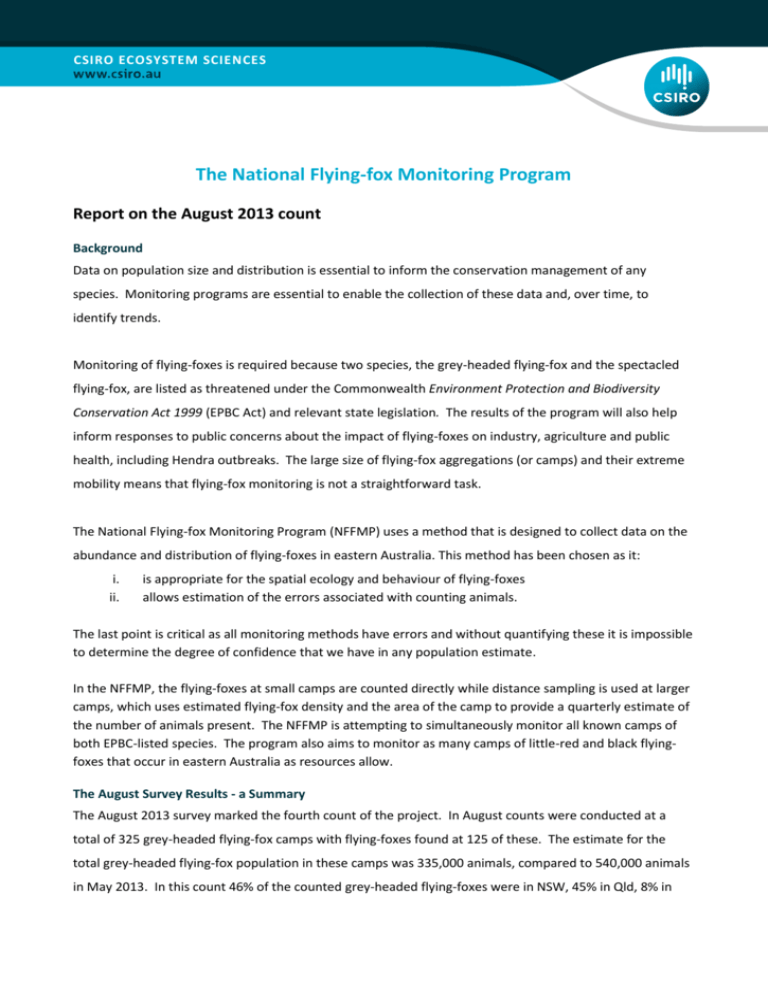
CSIRO ECOSYSTEM SCIENCES The National Flying-fox Monitoring Program Report on the August 2013 count Background Data on population size and distribution is essential to inform the conservation management of any species. Monitoring programs are essential to enable the collection of these data and, over time, to identify trends. Monitoring of flying-foxes is required because two species, the grey-headed flying-fox and the spectacled flying-fox, are listed as threatened under the Commonwealth Environment Protection and Biodiversity Conservation Act 1999 (EPBC Act) and relevant state legislation. The results of the program will also help inform responses to public concerns about the impact of flying-foxes on industry, agriculture and public health, including Hendra outbreaks. The large size of flying-fox aggregations (or camps) and their extreme mobility means that flying-fox monitoring is not a straightforward task. The National Flying-fox Monitoring Program (NFFMP) uses a method that is designed to collect data on the abundance and distribution of flying-foxes in eastern Australia. This method has been chosen as it: i. ii. is appropriate for the spatial ecology and behaviour of flying-foxes allows estimation of the errors associated with counting animals. The last point is critical as all monitoring methods have errors and without quantifying these it is impossible to determine the degree of confidence that we have in any population estimate. In the NFFMP, the flying-foxes at small camps are counted directly while distance sampling is used at larger camps, which uses estimated flying-fox density and the area of the camp to provide a quarterly estimate of the number of animals present. The NFFMP is attempting to simultaneously monitor all known camps of both EPBC-listed species. The program also aims to monitor as many camps of little-red and black flyingfoxes that occur in eastern Australia as resources allow. The August Survey Results - a Summary The August 2013 survey marked the fourth count of the project. In August counts were conducted at a total of 325 grey-headed flying-fox camps with flying-foxes found at 125 of these. The estimate for the total grey-headed flying-fox population in these camps was 335,000 animals, compared to 540,000 animals in May 2013. In this count 46% of the counted grey-headed flying-foxes were in NSW, 45% in Qld, 8% in Victoria and <1% were recorded in SA and the ACT. In Far North Queensland a similar seasonal decline in numbers in camps saw just 30,000 spectacled flying-foxes counted. Since February the total count, the number of occupied camps and the average camp size have all been decreasing. This decrease was anticipated and is possibly driven by the lack of social reasons, e.g. birthing or mating, to be in the camps at this time of the year. The largest recorded camp was one of 25,000 individuals at Blair Athol near Inverell, over 200km from the coast. There were still small numbers of animals at Tumut in NSW’s high country & Ingham in Far North Queensland (neither visible on the map). As the birthing season gets under way we are expecting that numbers will increase again to the highs that we saw last November and February. While the counts focused on the grey-headed and spectacled flying-foxes, black and little-red flying-foxes were also counted in the same geographic region. In total 142,000 black flying-foxes were recorded at 76 camps mostly in Qld, a slight reduction in numbers. However LRFF were only recorded in very small numbers, 290 individuals, at 2 camps in Qld. This is a very large drop from the 133,000 recorded in the region in May. Where were the flying-foxes in August? The heat maps show the distribution of the different flying-fox species across the region of the NFFMP. The darker the colour the greater the abundance of flying-foxes in an area. Black dots represent visited camps A reminder, we have provided numbers to give counters a feel for the outcome of the count and caution that at this point in time they are indicative only. We are still refining analysis methods and estimating some errors. As a consequence it is not yet possible to say what level of confidence can be assigned to the estimate. Describing the errors is a focus of our ongoing research. The aim of the program is to establish a reliable baseline estimate of the flying fox populations in 2013 and over time to estimate trends. This will take a number of years. Each quarterly count will be subject to various factors which may influence the results. For example, the February 2013 count took place shortly after severe storms and flooding in northern Queensland and an unprecedented January heat wave in south-eastern Australia, which saw many flying foxes stressed or killed. Comparing current monitoring to previous monitoring efforts is also difficult at this stage due to differences in the time of year in which surveys were conducted, the number and distribution of camps counted and the methods used. In order to achieve the best possible estimate it is important that surveys are performed using the methods correctly. We are continuing to conduct training sessions and the CSIRO urges any counters who have any questions or concerns about count methodology to contact Dr David Westcott on david.westcott@csiro.au or Mr Adam McKeown on adam.mckeown@csiro.au. We are continually updating the database and adding new camps as we were made aware of them. If you know of camps that are not being counted please contact the CSIRO. Thank you to all the counters who put in the hours to assist the program. Your effort is greatly appreciated. If you would like to participate please contact: New South Wales — Liza.Schaeper@environment.nsw.gov.au Queensland — Katrina.Prior@ehp.qld.gov.au If you know of additional camps or have questions about the counts please contact: david.westcott@csiro.au or adam.mckeown@csiro.au Additional information about the program can be found at: www.environment.gov.au/biodiversity/threatened/species/flying-foxes-monitoring-program.html The National Flying-fox Monitoring Program is collaboration between the Australian Government, the South Australian, Victorian, New South Wales, Australian Capital Territory and Queensland governments, CSIRO, local governments and volunteers in New South Wales and Queensland. The CSIRO was contracted by the Rural Industries Research and Development Corporation to undertake this research project. This research was funded by the Commonwealth of Australia, the State of New South Wales, the State of Queensland and the Corporation under the National Hendra Virus Research Program.
